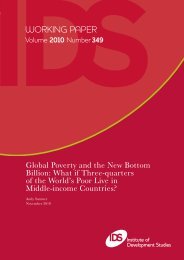IDS WORKING PAPER - Institute of Development Studies
IDS WORKING PAPER - Institute of Development Studies
IDS WORKING PAPER - Institute of Development Studies
Create successful ePaper yourself
Turn your PDF publications into a flip-book with our unique Google optimized e-Paper software.
emission trends, emission levels and climate policy (Germanwatch 2011). Despite this bad<br />
ranking, China ratified the United Nations Framework Convention on Climate Change<br />
(UNFCCC) Convention in 1993 (UNFCCC 2010a), approved the Kyoto Protocol in 2002<br />
(UNFCCC 2010b), and submitted Nationally Appropriate Mitigation Actions (NAMAs) as a<br />
follow-up to the Copenhagen Accord in early 2010 (UNFCCC 2010d). Nevertheless China is<br />
a non-Annex I country and doesn’t have quantified emission reduction targets.<br />
The Chinese government launched its National Climate Change Programme in 2007<br />
(NDRC 2007a) and its White Paper on Climate Change in 2008. The White Paper<br />
introduced national energy intensity targets for a 20 per cent reduction by 2010 in<br />
comparison to 2005 and targets for closing down inefficient coal power stations, decreasing<br />
the share <strong>of</strong> heavy industry, investing in energy efficiency and promoting renewable energy<br />
(Information Office <strong>of</strong> the State Council <strong>of</strong> the People’s Republic <strong>of</strong> China 2008). China’s<br />
much debated position at the Copenhagen and Cancun climate negotiations was a 45 per<br />
cent reduction in carbon intensity reduction by 2020 in comparison to 2005 (UNFCCC<br />
2010d).<br />
From an energy perspective, there are a range <strong>of</strong> policies and legislative frameworks in<br />
place to foster a low carbon economy, such as the Chinese Renewable Energy Law from<br />
2006 which aims to ‘promote the development and utilization <strong>of</strong> renewable energy’ (National<br />
People’s Congress <strong>of</strong> China 2005: 1). The law sets no specific targets for renewable<br />
energy, but provides the legislative framework for other policies, obligatory grid connections<br />
for renewable energy systems, cost-sharing agreements between utilities and end-users,<br />
pricing agreements like feed-in tariffs, surcharges and concessions to guarantee the market<br />
(Baker and McKenzie 2007; Urban et al. 2009). Other policies which promote low carbon<br />
energy are the Five Year Plans, most recently the 12th Five Year Plan for 2011–2015. The<br />
government body NDRC introduced Renewable Energy Targets in 2007 which are<br />
comparable to those <strong>of</strong> the European Union. Fifteen per cent <strong>of</strong> the total primary energy<br />
should be from renewable energy by 2020. This policy promotes biomass, geothermal<br />
energy, hydropower, solar power, tidal energy and wind energy and aims to use these<br />
renewable energy sources to achieve decentralised electrification in remote rural areas<br />
(NDRC 2007b; Urban et al. 2009).<br />
China is also a major benefiter <strong>of</strong> the Clean <strong>Development</strong> Mechanism (CDM). China has<br />
implemented the world’s greatest number <strong>of</strong> CDM projects and reported the largest<br />
emission reductions on the global CDM market (Wang 2010).<br />
2.1.2 The role <strong>of</strong> the state in climate change mitigation: China<br />
Despite the turbulent Copenhagen and Cancun climate change negotiations and the blame<br />
that China received from many sides regarding the weak outcome, the Chinese government<br />
is committed to tackling climate change. The Chinese government has realised the<br />
disadvantages that a high carbon pathway could bring and makes efforts to move towards a<br />
low carbon economy for three key reasons: (1) energy security, (2) economic<br />
competitiveness and first mover advantages, and (3) climate change mitigation. As a<br />
formerly centrally-planned economy and with a growing business sector, the Chinese state<br />
remains the driver <strong>of</strong> climate change mitigation actions and creates an enabling<br />
environment for low carbon businesses. A case in point is the wind sector. Wind resources<br />
in China are reported to be large. The World Energy Council’s World Energy Assessment<br />
2007 reports that China has 1,000 GW total exploitable wind energy resources (WEC 2007)<br />
<strong>of</strong> which 750 GW are reported to be situated <strong>of</strong>fshore (Lewis and Wiser 2007).<br />
The Global Wind Energy Council (GWEC) reports that China has doubled its installed wind<br />
energy capacity for the fifth consecutive year. The country had more than 25 GW installed<br />
wind capacity at the end <strong>of</strong> 2009 (GWEC 2010). The <strong>of</strong>ficial target <strong>of</strong> the government was to<br />
8

















